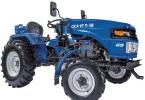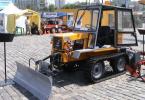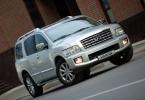The tire pressure level determines how the vehicle behaves when driving on the road. Therefore, it must be strictly controlled. Any deviations will negatively affect the adhesion efficiency of Hyundai Solaris to the road surface, which will reduce the level of driving safety. You can avoid troubles on the way if you follow the manufacturer's recommendations. They are indicated in the instruction manual or in the door arch where the driver sits. For Hyundai Solaris, 2.2 bars are optimal. The pressure value for the front and rear wheels is the same.
Determining this indicator is quite simple. For this, a special device is used that is easily connected to the wheel. In this case, the rubber must be cold, which guarantees the accuracy of measurements. It is recommended to carry out a similar procedure every day or once a week. This will avoid wear and tear on the rubber and save money.
Below is a table showing the tire pressures depending on the type and size of the wheels. It will come in handy for the owners of the Solaris car.
Wheel size and required tire pressure for Hyundai Solaris
|
15 inch tires |
|
| Tire size | 185/65 R15 |
| Pressure: | |
| Disk size | 6.0Jx15 PCD 4 × 100 ET48 DIA 54.1 |
| Wheel nut tightening torque | 107-127 N * m |
| Load index | 88 |
|
16 inch tires |
|
| Tire size | 195/55 R16 |
| Tire pressure (recommended cold tire pressure) | Pressure: Front: 2.2 bar (32 psi, 220 kPa) Rear: 2.2 bar (32 psi, 220 kPa) |
| Disk size | 6.0Jx16 PCD 4 × 100 ET52 DIA 54.1 |
| Wheel nut tightening torque | 107-127 N * m |
| Load index | 84 |
| Compact spare wheel | |
| Tire size | 185/65 R15 |
| Tire pressure (recommended cold tire pressure) | 2.1 bar |
| Disk size | 6Jx15 PCD 4 × 100 ET48 |
| Wheel nut tightening torque | 65.0–95.0 (6.5–9.5) Nm (kgfm) |
In winter, it is necessary to adjust the tire pressure. A 7 kPa (1 psi) decrease is allowed for every 7 ° C (12 ° F) drop in temperature.
Complexity
Tool5 - 30 minutes
Instruments:
- Balloon wrench
- Pressure gauge
- Compressor (if required)
- Ruler
Parts and consumables:
- Spool protectors (if necessary)
Note:
There is a decal on the left B-pillar of the car, which indicates the air pressure in the tires of different sizes.
The tire pressure on the front and rear tires 185/65 R15 and 195/55 R16 must be 220 kPa (2.2 bar). It is advisable to carry out all work on the repair of wheels in specialized workshops.
Check that the wheel is balanced after repair.
1. Unscrew the cap from the valve.

2. Check the tire pressure. To do this, connect the pump tip with a pressure gauge.

3. If the pressure is less than required, pump air, monitoring the pressure on the pressure gauge.

4. If the pressure is greater than required, push down on the spool tip and deflate the tire. Measure the pressure with a pressure gauge. By repeating these operations, bring the pressure back to normal.

5. If you notice that the tire pressure is constantly dropping, try tightening the valve tighter using the key cap.
Note:
This is what the protective cap with a key for tightening the valve looks like.

A warning:
To avoid contamination of the spools, do not operate the vehicle without protective caps. If the caps have been lost, be sure to install new ones.
6. To check the tightness of the spool, wet the valve opening.

7. If air bubbles appear, replace the spool by unscrewing the faulty one using the cap and wrench.

8. Measure the residual tread depth with a ruler or vernier caliper. If the tread depth is 1.6 mm or less, replace the tire (for winter tires, the remaining tread depth is 4.0 mm).

9. If you do not have a caliper or ruler at hand, the tread depth can be checked visually using the tire wear indicators in the form of continuous transverse stripes on the tread.

Note:
The locations of the indicators are marked on the tire sidewall with a triangle or the letters "TWI".

Mark the location of the indicators on the sidewall of the tire.
10. Check the tightness of the wheel nuts with the correct tool.

Note:
The bolts must be tightened crosswise.
USEFUL TIPS:
Check the tire pressure periodically. Increased or decreased pressure leads to premature tire wear, deterioration of vehicle handling and stability, increased fuel consumption, and wheel deformation.
A significant drop in pressure (70 kPa or more) can lead to a significant increase in heating and cause tire bursts, tread peeling and other tire damage, resulting in loss of vehicle control, which in turn can lead to serious injury or death.
The risk of such overheating increases significantly on hot days or when driving for long periods of time at high speeds. Increased tire pressure leads to increased sensitivity to bumps in the road, excessive wear in the middle of the tire tread and an increased likelihood of tire damage due to defects in the road surface. Maintain the rated tire pressure.
Use a high quality pressure gauge to check your tire pressure. The conformity of the air pressure in the tire to the recommended value cannot be determined by external signs without taking measurements. Radial tires can look normally inflated even under reduced pressure.
Check the air pressure when the tires are cold. Cold tires are considered to be the tires of a car that has not been in motion for at least 3 hours or has driven less than 1.6 km.
If the tire pressure when cold is within the recommended pressure indicated on the tire and on the vehicle load rating plate, no further pressure adjustment is required. If the pressure is low, inflate the tire until the recommended pressure is reached.
If the tire pressure is too high, bleed the air by pressing the metal rod in the center of the tire charge valve. Recheck the pressure on the gauge. Make sure that the valve stems are capped when work is completed. This will prevent leaks by providing protection against the ingress of dirt and moisture.
Using wheels and tires that are not of the recommended dimensions may alter the driving characteristics and impair the vehicle's handling, which could result in a serious road accident.

To ensure that the tires wear evenly, change the wheels in accordance with the diagram every 12,000 km.
In addition, balance the wheels and check the alignment angles of the front wheels every 15,000 km. To do this, contact a specialized workshop.

Wheel rearrangement diagram.
The article is missing:
- Photo of the instrument
- Photos of parts and consumables
Hyundai
In car tires, the pressure should be monitored at intervals of 2 times a month. This will significantly reduce carbon dioxide emissions, reduce fuel consumption and extend the life of the tires themselves. Do not forget about comfort, which is not very pleasant in driving on over-pumped tires. In the table below, we suggest that you familiarize yourself with the recommended tire pressure of Hyundai vehicles.
| Hyundai tire pressure table | ||||||
| Model | Mode Standard | Comfort mode | Sport mode | |||
| previous | rear | previous | rear | previous | rear | |
| Solaris | 2,2 | 2,2 | 2,0 | 2,0 | 2,8 | 2,8 |
| i30 | 2,1 | 2,1 | 1,9 | 2,0 | 2,7 | 2,7 |
| i40 | 2,4 | 2,4 | 2,2 | 2,2 | 2,8 | 2,8 |
| ix35 | 2,3 | 2,3 | 2,0 | 2,0 | 2,8 | 2,8 |
| Sonata | 2,2 | 2,2 | 2,1 | 2,1 | 2,8 | 2,8 |
| Santa fe | 2,1 | 2,1 | 2,0 | 2,0 | 3,0 | 3,0 |
Solaris pressure
The pressure in Hyundai Solaris cars is indicated on the door arch. It is recommended to pump tires Solaris 2.2 bar, regardless of the tire size. Naturally, this is the pressure in cold tires, i.e. a car that has been at rest for 30 minutes. If you measure the pressure in hot tires, then it will be higher than recommended for Solaris. For the economy mode, it is recommended to pump the tires up to 2.8 bar, this will allow, albeit insignificantly, but still save on fuel. Although, perhaps, to the detriment of saving on tires.
How much pressure should be in Santa Fe
Santa Fe belongs to the class of small SUVs, so the pressure in its tires can vary significantly depending on the operating conditions and the tires installed. The suspension on the Santa Fe is soft, so you only need to keep the tires with low pressure when you need it, for example, when we are driving on a muddy forest road, or you need to reduce the pressure to lower the car's height by 2-5 cm.
Winter tire tests:
Well, we had to come to Sweden twice. The first time we sat for a week, skating the entire program of tests on snow and ice. And then, already in April, on the roads that had just been cleared of ice, they measured the braking distance on wet and dry asphalt - and assessed the acoustic comfort and smoothness of the ride. Well, then, using the traditional system of translating results into points, they summed up the results.
In our next big spike test, we collected six sets of 15-inch tires from Western and Eastern manufacturers. Some have experience and the latest technology among their trump cards, while others have the will to win and affordable prices. Whose will it take?
This time we have chosen one of the most popular dimensions - 195/65 R15, which suits many small and inexpensive cars. Different markets, different understanding of the product, different design schools. What distinguishes tires from the East and West from each other, what are their strengths and weaknesses, and what should a Russian buyer pay attention to?
If you are reading this article, then the words "winter is coming" are a call to action for you. Moreover, we have collected for you the best of 80 winter tires and invited you to vote for the best in our rating. See the results. And so, we will make a rating of TOP-20 tires for winter 2018 and consider non-studded tires for crossovers and SUVs.
In the next comparative test of winter tires of the popular "crossover" dimension 215/65 R16, 23 models came together - an absolute record of mass production in the entire history of Autoreview tests! Not only did we manage to grasp the immensity, but along the way, we also stopped the shipment of one of the consignments of Nokian tires ...
Summer tire tests:
In recent years, OE tire sizes have increased significantly. Gone is the time of tires R13 175/70 for Zhiguli, now the priorities are "huge sandals". This is due to the latest trends in the world and the increased demand for SUVs. Let's consider the test in which the Autoreview employees tested the sizes 215/65 R17 and 255/45 R19, which are native to Tiguan. In the first size 6 models appeared on the starting grid, the second size was presented by 5 models.
Models in different sizes are different because most tires in large sizes are made in UHP format. These changes are dictated by the sporty style of the large wheel sizes.
The cheaper the tires, the easier the choice? No, harder! We tested twelve sets of 185/60 R14 summer tires for the most affordable cars. And not only put all the participants in their places, but also found out what an attempt to save money on a purchase can turn out to be.
Tires 185/60 R14 are bought, as a rule, by the owners of Lada cars and older foreign cars. Small sizes are of little interest to tire manufacturers due to their low profitability. Decent novelties in this segment are rare. However, tire manufacturers, who seriously care about their image, try from year to year to improve, though familiar, but quite successful models.
We test summer tires with dimensions 195/65 R15 for relatively inexpensive cars and see how their characteristics have changed dramatically over the past ten years.
Nowadays, even small and inexpensive cars roll off the assembly line on 15-inch wheels. Many Russians even put “tag” with a higher profile on rather expensive cars - they are preferable on our roads. Shinniks, for whom income depends more on the sizes of tires sold than on their number, are indifferent to the budget dimensions. New items are offered at least in the "seventeen" segment, and small sizes are sluggishly updated, usually slightly reducing rolling resistance.
Nevertheless, there are companies for which the Russian market is very important, and they literally fight for the leading positions, annually “polishing” their products, trying to outstrip competitors in adhesion properties on dry and wet surfaces. Therefore, there is always intrigue in our tests.
Do you know which indicator is one of the main factors in determining the behavior of your car while driving on the road? This indicator plays an important role in the efficiency of adhesion to the road surface, which, in turn, directly affects the level of travel safety. Ensuring the proper level of this indicator recommended by the car manufacturer is one of the most reliable options for avoiding problems along the way.
Of course, we are talking about tire pressure level... And today we will get acquainted with information about this important indicator from the words of experts.
Measurement of pressure
Remember the last time you measured the tire pressure of your car? You may recall that you recently changed your summer tires to winter tires, so you don't need to worry. And how many atmospheres did you pump when replacing? You do not know this, and this is not surprising, because Russian experts usually determine the pressure "on the eye". Driving instructors it is strongly recommended to monitor this important indicator constantly.
The recommended tire pressure for Hyundai Solaris is 2.2 bar or 32 psi for both front and rear wheels. Translated into more understandable units, this will be about 2.2 atmospheres. It should be added that experts recommend monitoring the tire pressure simultaneously with refueling the car. Such frequent monitoring will help to avoid rapid wear of the rubber and thus save money.
Check the air pressure of all tires (including the spare wheel) daily.
The check is carried out with cold tires. A “cold” tire is a tire that has not been in motion for at least three hours or has traveled less than 1.6 km (1 mile).
All technical specifications (dimensions and pressures) are shown on a plate affixed to the vehicle.
CAREFULLY
- insufficient tire pressure
Severe pressure drops can lead to a sudden increase in heating, causing tire bursts, tread peeling and other tire damage, which can result in loss of vehicle control, which in turn can result in serious injury or death. the risk of such overheating increases significantly on hot days or when driving at high speeds for extended periods of time.
ATTENTION
Low tire pressure also leads to excessive wear, poor handling and increased fuel consumption. Wheel deformation can also occur.
Maintain the correct tire pressure. If the tire has to be inflated frequently, it should be checked by an authorized HYUNDAI dealer.
Increased tire pressure leads to increased sensitivity to road irregularities, excessive wear in the middle of the tire tread, and an increased likelihood of tire damage due to defects in the road surface.
ATTENTION
The air pressure in hot tires is usually 28 ~ 41 kPa (4 ~ 6 psi) higher than the recommended cold tire pressure. Do not bleed hot tires to regulate pressure. Otherwise, the pressure will be below the recommended level.
When finished, be sure to install the protective caps on the tire valves. If the cap is missing, dirt or moisture can enter the inside of the valve and cause air leakage. If the protective cap is lost, replace it with a new one as soon as possible.
CAREFULLY
- tire inflation
too high or too low tire pressure will reduce tire life, adversely affect vehicle handling and can lead to tire damage. This, in turn, can lead to loss of vehicle control and injury.
ATTENTION
- Tire pressure Always follow the guidelines below:
Check the air pressure when the tires are cold. (After the vehicle has been parked for at least three hours or has traveled no more than 1.6 km after parking).
Check the tire pressure of the spare wheel every time you check the tire pressure.
Do not overload the vehicle. Be careful not to overload the roof rack (if equipped).
Worn, old tires can cause accidents. If the tread is badly worn or the tires have been damaged, they should be replaced.
Other on the site:
Additional equipment - Control panel illumination of a combination of devices, Horn, Electric heated rear window
The dash panel illumination level regulator allows you to change the degree of illumination of the instrument cluster indicator scales depending on the amount of outdoor lighting by rotating the ribbed hand ...
Interior lamp
The interior lamp has a three-position switch that can be set to the following positions: - 014 "MIDDLE" position, the interior lamp comes on when open ...
AUTOMATIC CLIMATE CONTROL (IF EQUIPPED)
AUTOMATIC CLIMATE CONTROL 1. Temperature regulator 2. Air conditioner button 3. Air intake control button 4. Windshield heating button 5. Vent switch ...



